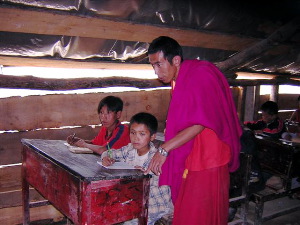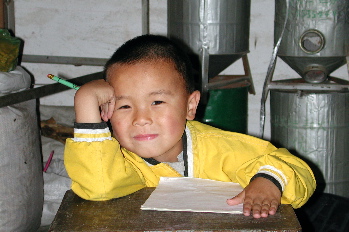South China Morning Post, January 10, 2004
Language Lessons
China’s minority languages are in danger of disappearing
By PAUL MOONEY in Beijing
It's midday and about a dozen young students are sitting at old wooden desks in a makeshift classroom in the Kham Mountains in Yunnan province. The students are focused on a burgundy and saffronclad Tibetan monk pointing to Tibetan words on a rough blackboard.
Such scenes are rare in Tibetan areas in southern China, where only a few private schools teach Tibetan children to read and speak their mother tongue or learn about their culture.
Katarina Tomasevski, the United Nations Special Rapporteur on the Right to Education, last month in a special report criticised China’s education of minority children, saying that the system denied these students their religious and linguistic identity. Ms Tomasevski, who visited China last September, expressed particular concern about the survival of minority languages in China, quoting a Unesco report which found that out of the more than 120 languages spoken in China, half were endangered.
 Polls conducted among minorities in China show that parents ideally want their children to be bilingual. The problem is that no one has come up with a way to achieve both goals.
Polls conducted among minorities in China show that parents ideally want their children to be bilingual. The problem is that no one has come up with a way to achieve both goals.
Conventional wisdom says that it’s importantfor students to maintain their native languages. “There are many studies that say mother tongue instruction can enhance the cognitive skills of students,” says Maki Hayashikawa, an education expert working for Unesco.
“I have a problem with this,” counters Chen Mingxiang, head of the Education and Human Development Department at Beijing University. “In terms of their future, it seems the children have to learn Mandarin [Putonghua], especially when they are living together with Han Chinese. In terms of the learning process, the use of the native language is very important.”
Studies show that native language education results in higher retention rates. In one Tibetan school in Zhuoni county, Gansu province, almost half the students dropped out because the medium of instruction was Chinese. When the school revised its curriculum to use Tibetan, enrolment almost doubled.
This point was proved in the early 1950s, just after the communists came to power. The government saw bilingual education as a critical commitment, and it formulated policies to promote native language education.
With the beginning of radical political campaigns in the mid-1950s, however, the government began to reverse its emphasis on minority languages, with restrictions placed on minority schools that lasted until 1976. Teng Xing, director of the Institute of Ethnic Education Studies at the Central University for Nationalities in Beijing, says that minority students’ achievement levels dropped significantly during this period, and that “basic education in the minority regions lagged immeasurably”.
Reforms started in the late 1970s put renewed emphasis on the freedom to teach minority languages. Professor Chen, a Harvard PhD who has done extensive research in minority education, says, however, that most minority parents are “very pragmatic”. “Almost all the parents we interview say they want their children to learn Mandarin.”
She says that the main force behind minority language education is often community members who have become successful. “They see minority language and culture as an asset, and call for its preservation,” she says. “I can see that this comes from the bottom of their hearts, and that there’s a sense of crisis, but parents are more concerned about survival, and they can’t really see how their children can survive if they don’t learn Mandarin as away of life.”
 Conversations with Tibetan farmers in Shangri-La, Yunnan, confirm this dilemma. “What’s the point of my son learning to read Tibetan?” asked one farmer. “What will this do for him after he graduates?”
Conversations with Tibetan farmers in Shangri-La, Yunnan, confirm this dilemma. “What’s the point of my son learning to read Tibetan?” asked one farmer. “What will this do for him after he graduates?”
In some cases, local officials are reluctant to promote native languages in schools. “Teachers are beginning to come under pressure from parents who are now asking: ‘What will happen after graduation if the medium of instruction is not Chinese?’” says Gerry Postiglione, an expert on China’s education system at the University of Hong Kong.
Critics say that Chinese language education erodes the indigenous culture of minority groups, making them more modern and Sinocised. Dru Gladney, an expert on Xinjiang at the University of Hawaii, argues that this is not necessarily so. “Loss of a minority language is not necessarily the same as the loss of a minority culture,” he says. Gladney says Uygurs and Tibetans have told him they have to survive as a people first, “and then go back and reclaim their indigenous language”.
Mr Teng says that minority languages are falling into decline as the country modernises, and under the pressure of globalisation, with many young people now preferring to learn either Putonghua or English. “Minority languages and cultures are becoming weaker and weaker, and the situation is now critical,” he says. “The question is how to transmit the knowledge of mainstream society while at the same time retaining the traditional minority culture.”
Mr Teng argues that minority groups themselves don’t know which way to go. “If they try to keep their traditional culture, they will become marginalised by mainstream society and will become poorer and poorer. “Mainstream society today is a free market society and you need competitive knowledge to survive. Minority languages and cultures are of no use in a market society. Minorities may want to sustain their culture, but it’s very difficult. In 10 to 20 years, minority languages in China will become languages found only in museums. This is the reality,” Mr Teng says.
Laws promulgated during the past two decades guarantee the right of minority nationalities to use their own language in education. However, implementing government policies has not been so easy. China has 55 minorities – accounting for 8 per cent of the population, and 50-60 per cent of the territory – speaking 61languages. Only 21 of these languages have written scripts, and only 10 are used in schools.
Two basic teaching models dominate minority language education. One uses Putonghua as the form of instruction, with local languages taught as a second language. The other is the reverse.
Mr Teng says the local language model was put into use in Liangshan, a Yi minority area in Sichuan province, in 1974. Twenty-two years later he travelled there to do fieldwork, interviewing both teachers and students. He found that native language students had difficulties at university work because their Putonghua was poor – the writing ability of high school seniors was in some cases equivalent to sixth grade of primary school.
And then there is the shortage of suitable textbooks in minority languages. The White Horse Mountain Tibetan School is a good example. Textbooks are tattered and few, with two students often sharing. The school uses whatever Tibetan language teaching materials it can find, gathering an assortment of books published by minority language presses, from Qinghai, to Yunnan, Tibet and Beijing.
Mr Teng points to the example of the Lahu, a small minority group in southern China. The group has a written form of language, but aside from Bibles which use a script introduced by foreign missionaries before 1949, there are no newspapers or books that use the written form of the language. A campaign was launched by the local government to teach the Romanised written language, which people mastered in just three months. “But when the people finished the class, they had nothing to read, and in just one or two years they forgot it and became illiterate again.” Some of the younger Lahu no longer even speak their own language, he says.
An article on ethnic education that appeared in China Rights Forum, a publication of Human Rights in China, quoted Tibetan scholar Baden Nima on the importance of relevant teaching materials: “Minority nationality children become very self-abased when they find no reference to their own culture or history in school materials. When there is no content which can make them feel proud about being a person of their own nationality, they lose self-esteem.’’ The scholar says this is reflected in the high drop-out rates of minority children.
During a recent visit to Bai, Naxi and Tibetan minority villages in Yunnan province, many school-age children were seen playing at home during school hours. In three of the villages, each with populations of more than 350 people, only two students were in high school, and these were in vocational schools.
Professor Chen says being successful does not mean traditional languages and cultures have to be abandoned, which could hurt a child’s self-esteem. She favours a transitional model that offers native language instruction for the first one to three years, gradually phasing in Putonghua. To do this, she says, the whole curriculum would have to be changed, with new textbooks written and more emphasis on bilingual education.
A new national curriculum will go into effect by 2005 that will allow schools to dedicate 16-20 per cent of their class time to a school-based curriculum and teach about the local environment and things more relevant to the lives of students.